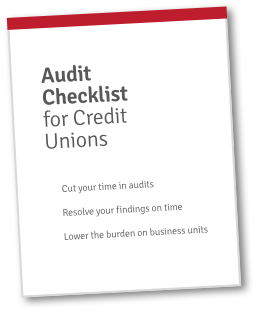In 2019, Boeing executives announced a plan to eliminate up to 900 quality control inspection jobs. Several years and two high-profile equipment failures later, Boeing is reversing course.
Credit union auditors can find a few takeaways from Boeing’s dramatic reversal.
Read on to see what auditors can take from the latest Boeing scandal. Here’s hoping the doors don’t have to blow off your credit union before leadership cares.
What Happened at Boeing, Abridged
After Boeing’s 2019 announcement to cut QC activity, several mechanics and inspectors raised red flags. They had just missed a key target in their latest QC audit.
Not long after, the 737 MAX crashes occurred, and Boeing scrapped its plan to cut QC activity. In January 2024, the 737 MAX again made headlines when a door blew out midair due to loose bolts.
Now, Boeing is bringing in more QC inspectors—and letting airlines in on the process, too.
Takeaways for Credit Union Auditors
There are several ways to learn from Boeing’s recent high-profile failures. We could dive into an examination of the 3 lines of defense. We could pinpoint where Boeing’s risk assessment went wrong. We could even discuss how Boeing drew up policy that flew in the face of audit findings.
But the most important takeaways for credit union auditors are the questions this situation raises:
- What’s at stake for the credit union? In the Boeing example, lives are at stake. Clearly, if your credit union has a problem no one is going to die. Yet, livelihoods may be at stake. And which risks are you most concerned about?
- What’s your general tolerance for defects? Your tolerance might not be as low as Boeing’s, but where do you draw the line?
- Which business areas require a lower tolerance for defects? In your risk assessment, which areas of the credit union take precedence?
- Which business areas can succeed with a higher defect rate? For Boeing, there’s a difference between flight software failure and misaligned seat screws. What about your credit union?
- What level of quality control do you need to enforce? Boeing tried to cut QC despite audit findings that suggested they should increase it. How can you ensure your credit union acts on your recommendations?
- What audit activity needs to back up quality control? What can you do to support or empower the QC process?
At this point, if you’ve been following Boeing’s situation, you’ve probably already analyzed their faults.
Now, the best way to learn is to ask yourself the same questions that seem to have gotten lost somewhere between Boeing’s audit and risk team and the executive suite.
Resources for Credit Union Auditors
Although Redboard can’t help you answer those questions, we can help you organize your audit process. These free resources might help:
Redboard’s Credit Union Audit Checklist organizes audits before you begin.
Our Unresolved Findings Eliminator worksheet structures the findings process for clarity and transparency.
Photo by Bao Menglong on Unsplash


 Get FREE Access to the Audit Checklist for Credit Unions!
Get FREE Access to the Audit Checklist for Credit Unions!


